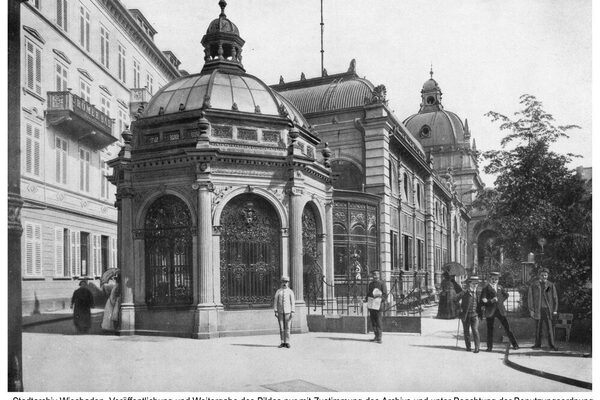Cooking fountain
The Kochbrunnen is Wiesbaden's best-known thermal spring, which was already in use in prehistoric times, but especially by the Romans in the first century AD. Originally only a shallow spring pond, it was later surrounded by a wall.
After the Second World War, it was dug 43 m deep as a drilled well in 1966 to protect it from contamination from its surroundings. The temperature rose from 37 °C to 67.5 °C. As the water level was 3.1 m above ground level, the well was designed as a "jumper". The granite well was built in 1970. The borehole encountered the following layers in the subsoil: 0.00 to - 0.50 m clay, topsoil and cultural debris; up to 0.70 m mortar, cultural debris; up to 1.20 m cultural debris with bones and red bricks; up to 1.70 m cultural debris; remains of a clay jug; up to 8.00 m sand and coarse gravel (gravel from the Schwarzbach stream) and up to 47.00 m sericite gneiss; lots of sulphur gravel, gangue quartz, barite and red iron on fissures. The borehole was sealed by cementation up to 18 m below ground level.
A few meters to the southwest lies the Spiegelquelle (mirror spring) as a satellite in front of the rising wall of the former palace hotel. It is no longer in use. The Salm spring, located 40 m to the north-east, was also replaced in 1965 by a 47 m deep borehole. Like the Kochbrunnen borehole, it encountered sandy stream gravel from the Schwarzbach below 2.60 m of cultural debris up to 8.10 m below ground level, including the sericite gneiss characteristic of Wiesbaden.
Literature
Michels, Franz: The Wiesbaden mineral springs. In: Jahrbuch für Nassauische Naturkunde 98, Nassauischer Verein für Naturkunde (ed.), Wiesbaden 1966 [pp. 17-54].
Stengel-Rutkowski, Witigo: Hydrogeological guide to the saline thermal springs of Wiesbaden. Ed.: Nassauischer Verein für Naturkunde, Wiesbaden 2009.
